The Wholesale Electricity Market
Spot prices in the wholesale electricity market fell again during July. Average spot prices for the month ranged from $100 in the central North Island (down from $119 in June), up to $108 in the upper South Island ($132 in June).
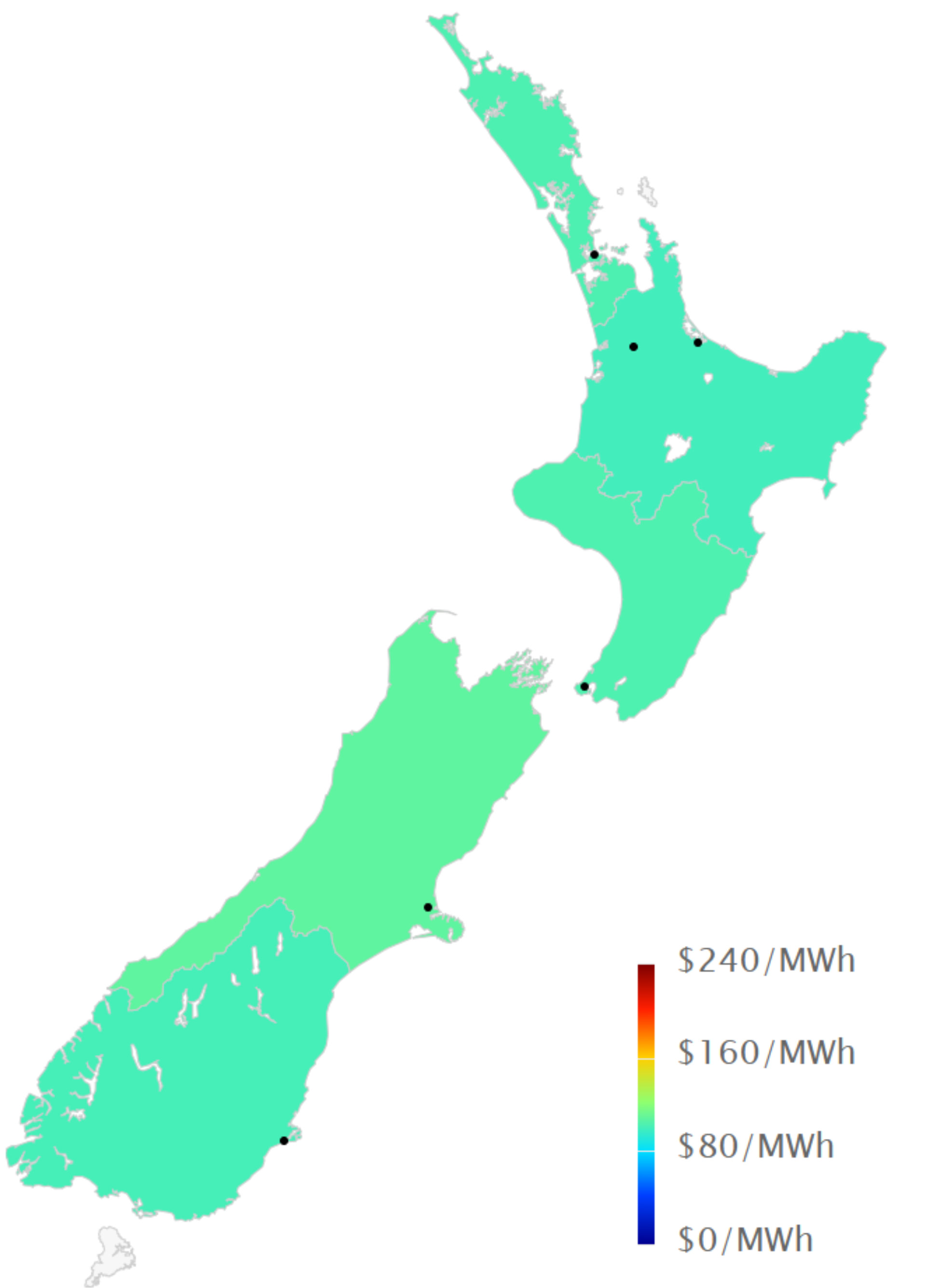
The following chart shows average weekly spot prices over the last 2 years. The recent drop off in prices can be clearly seen.
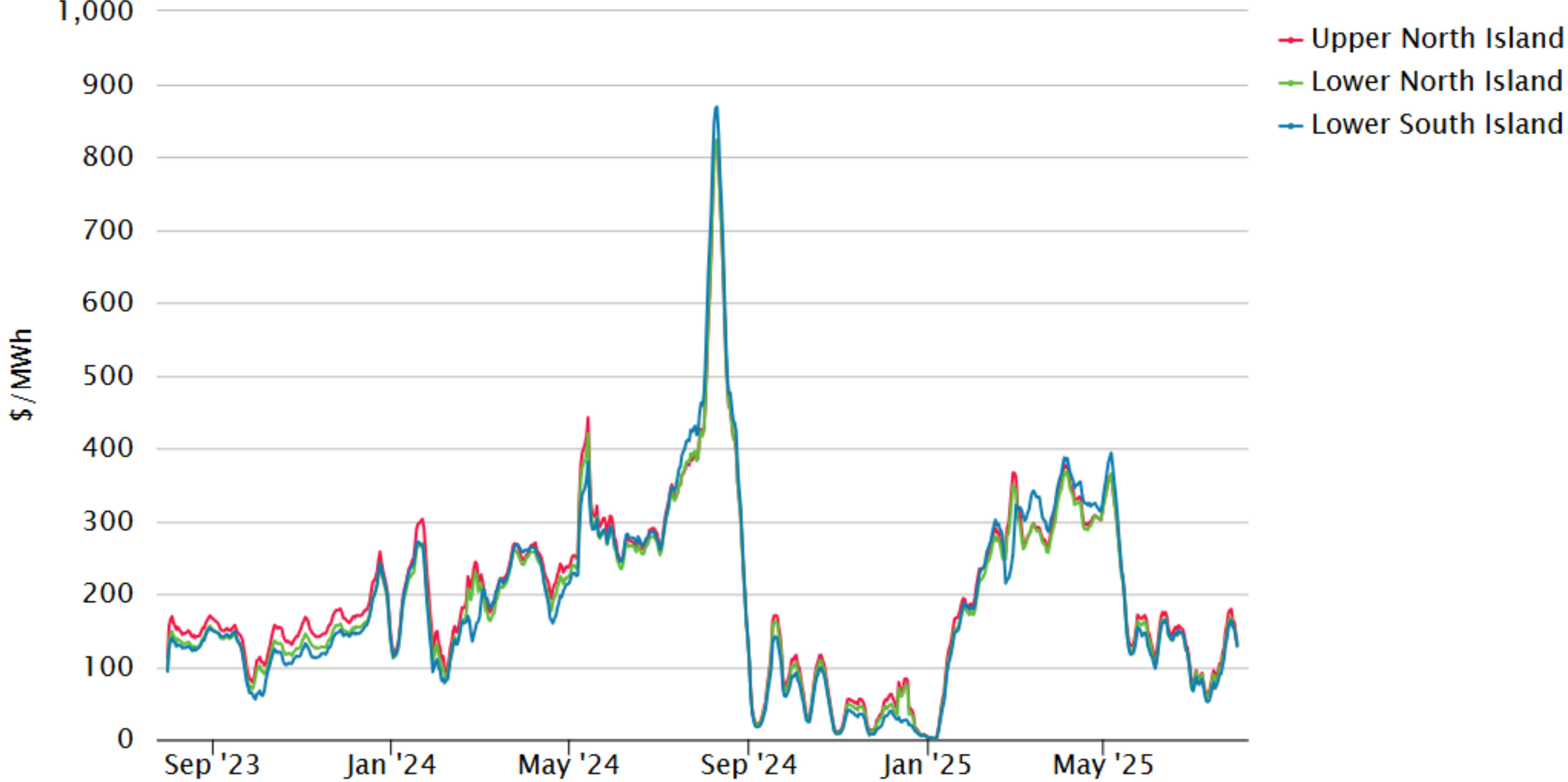
Electricity Demand
Electricity demand in July was low for much of the month but increased in the back end with colder weather pushing through the country as shown below.

Electricity Generation Mix
Higher levels of hydro generation allowed thermal generation to remain low for much of July, though the increased demand at the end of the month was largely picked up by increased thermal generation.

HVDC Transfer
Power transfers on the HVDC link connecting the North and South Islands are important both in showing relative hydro positions and the reliance on thermal power to meet demand. High northward flow tends to indicate a good SI hydro position, whereas the reverse indicates a heavy reliance on thermal power to make up for hydro shortages.
Northward transfer increased during July to enable SI storage to be utilised with increased NI demand. However southward transfer also persisted through most of the month but at lower levels than recent months

The Electricity Futures Market
The Futures Market provides an indication of where market participants see the spot market moving in the future. They are based on actual trades between participants looking to hedge their positions (as both buyers and sellers) into the future against potential spot market volatility. They are also a useful proxy for the direction of retail contracts.
The following graph shows Futures pricing for CY 2025, 2026, 2027 and 2028 at Otahuhu (Auckland) for the last 2 years.
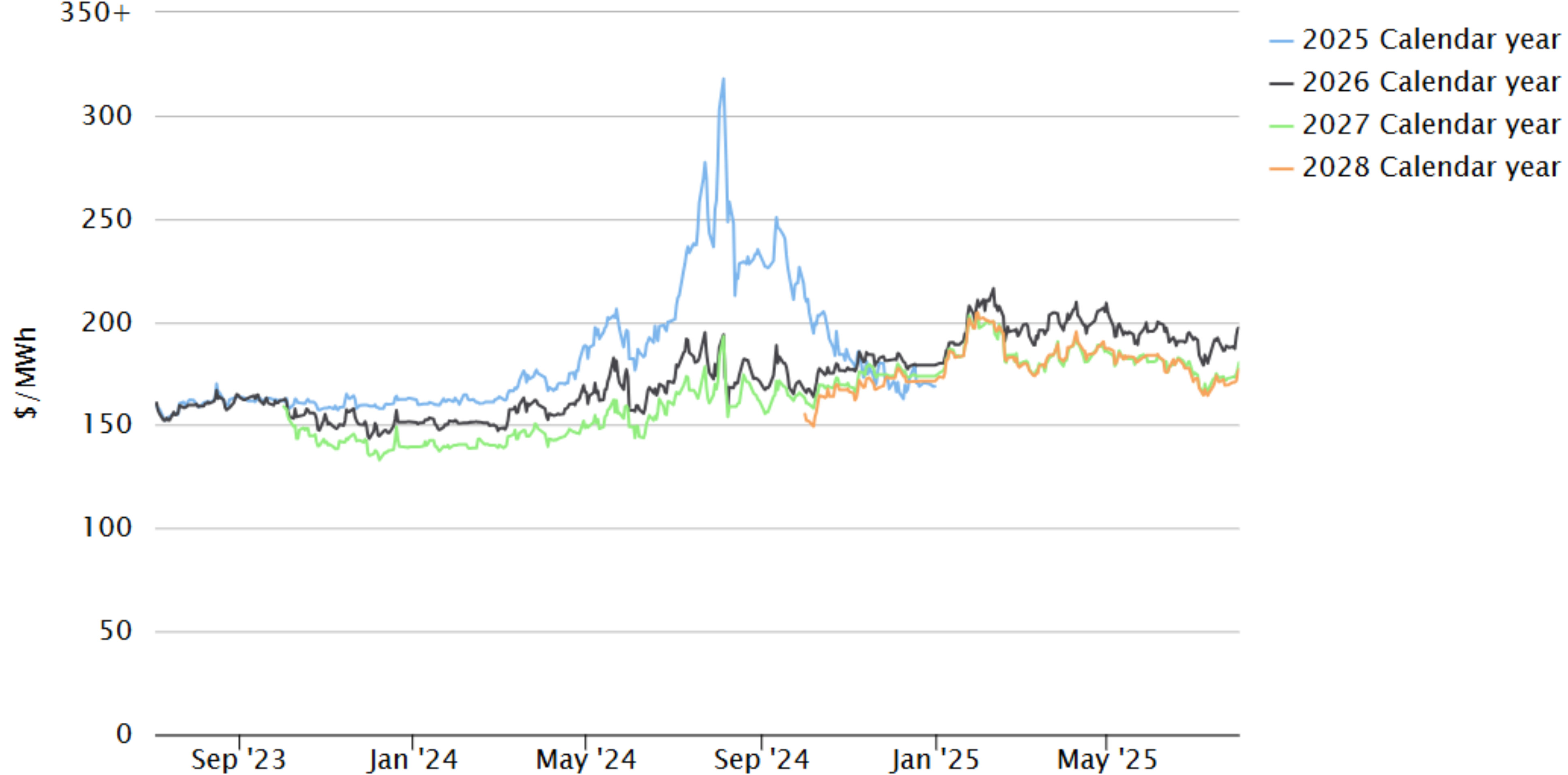
Note that $100/MWh equates to 10c/kWh.
Forward prices were up for all years through July. CAL 2026 ended the month at $197/MWh – up 3% over the month. CY 2027 price was up 2% at $177 while CY 2028 also increased 2% at $174.
Known new generation projects are shown below (additions / removals / changes highlighted in bold).
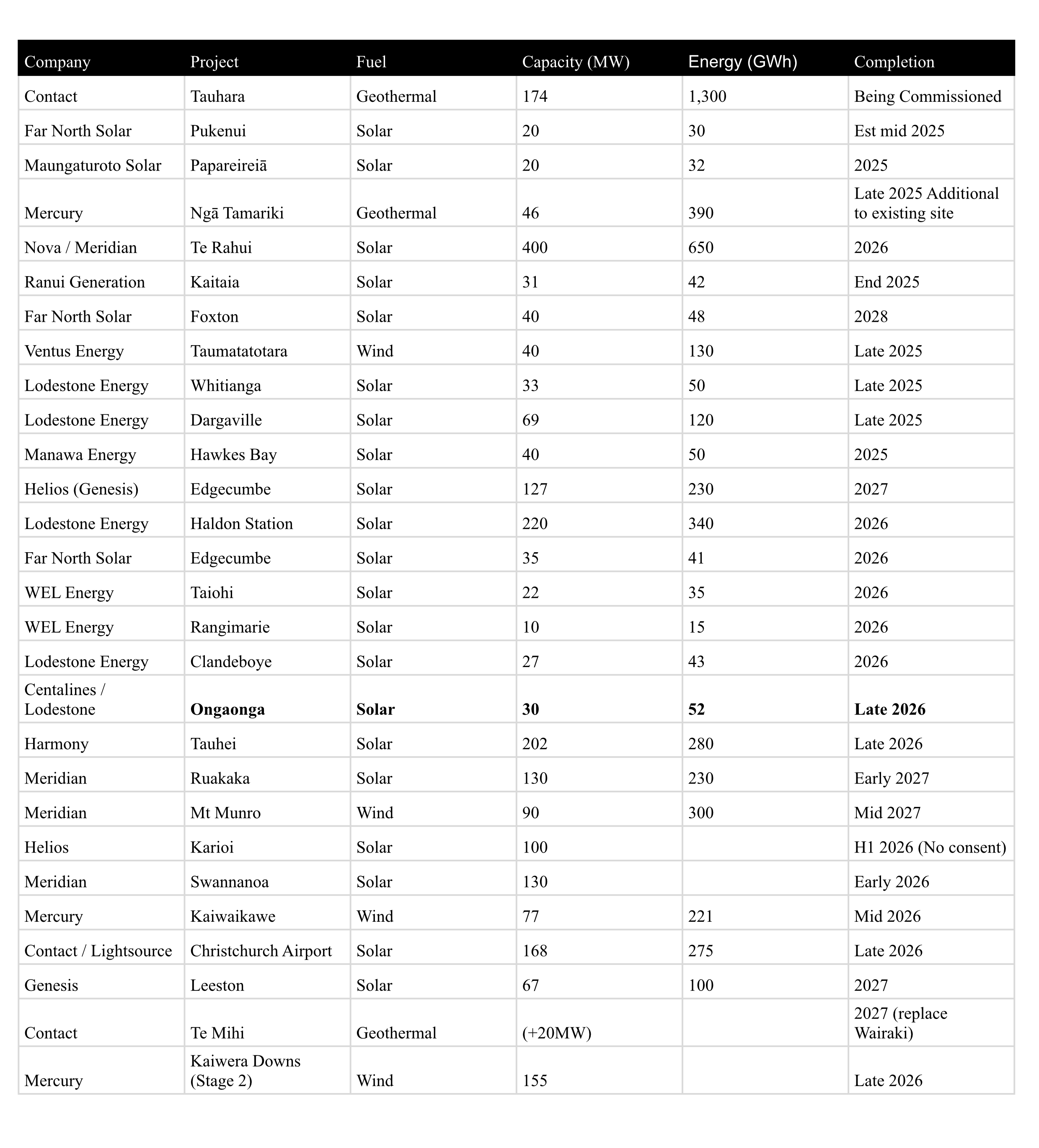
Hydro Storage
Inflows were above average in both islands last month, but particularly the North Island as shown below.

The high inflows didn’t result in increased storage as high levels of hydro generation more than negated the inflows. Energy storage levels decreased 395GWh through the month to end at 2,731GWh (60% full). Storage is now slightly below the average level seen at this time of year. The following chart shows the latest breakdown of storage across the main hydro catchments.
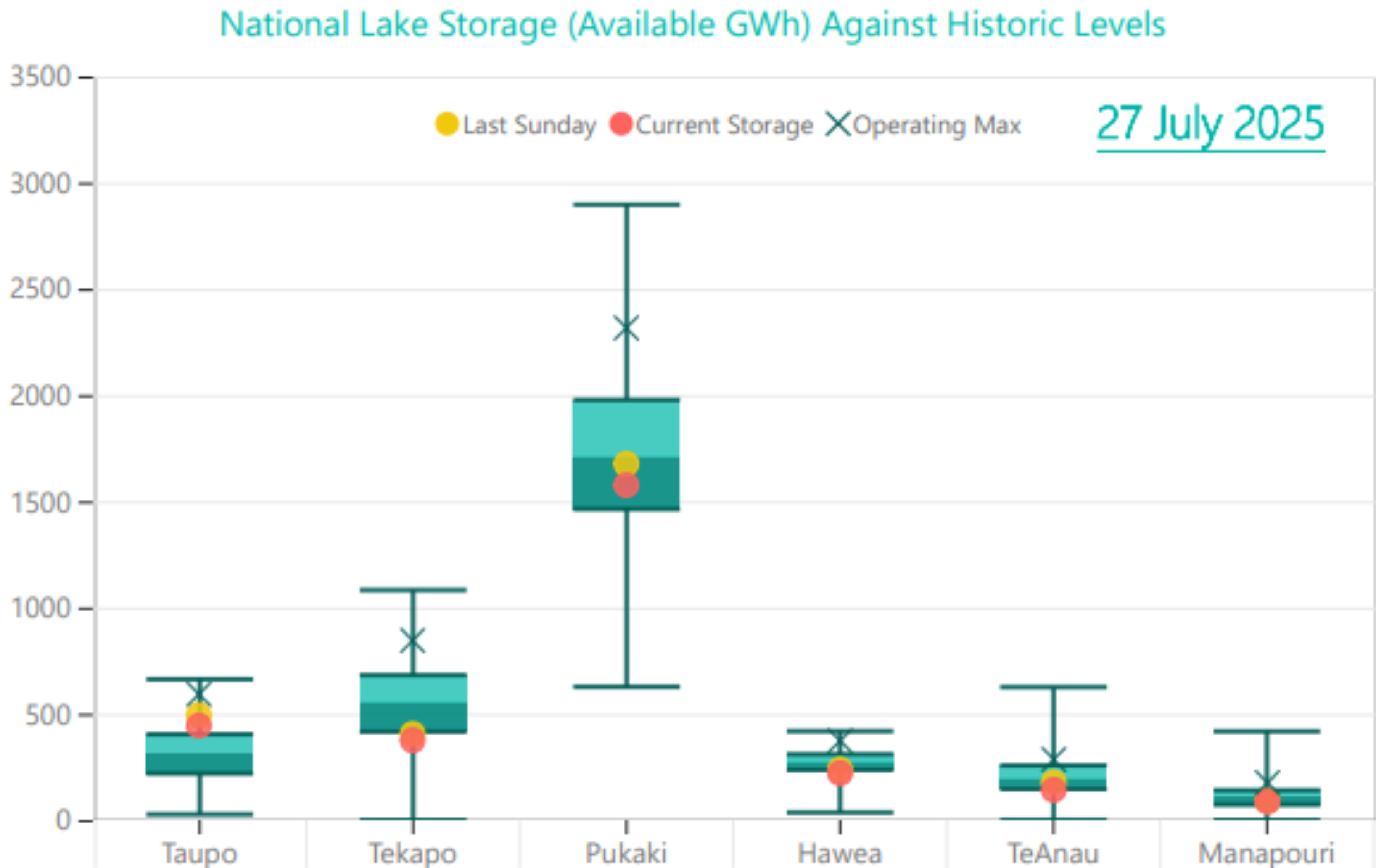
Security of supply risks decreased through May with storage levels increasing as shown below.
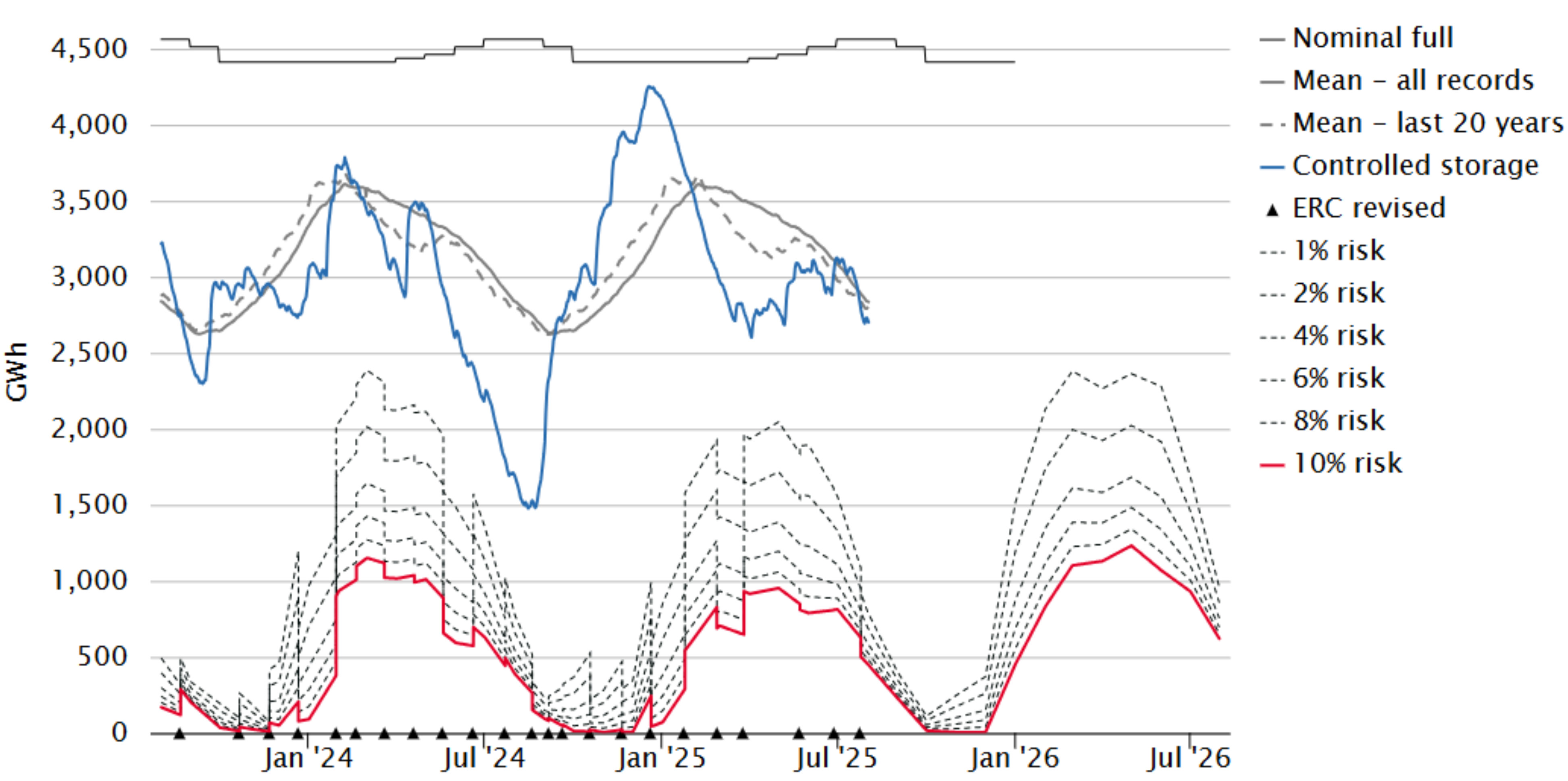
Snowpack
Snowpack is an important way that hydro energy is stored over the winter months and released as hydro inflows in the spring. The following graph shows that the snowpack in the important Waitaki catchment increased during July but remains slightly below the 25th percentile levels seen in the last 30 years for this time of year.
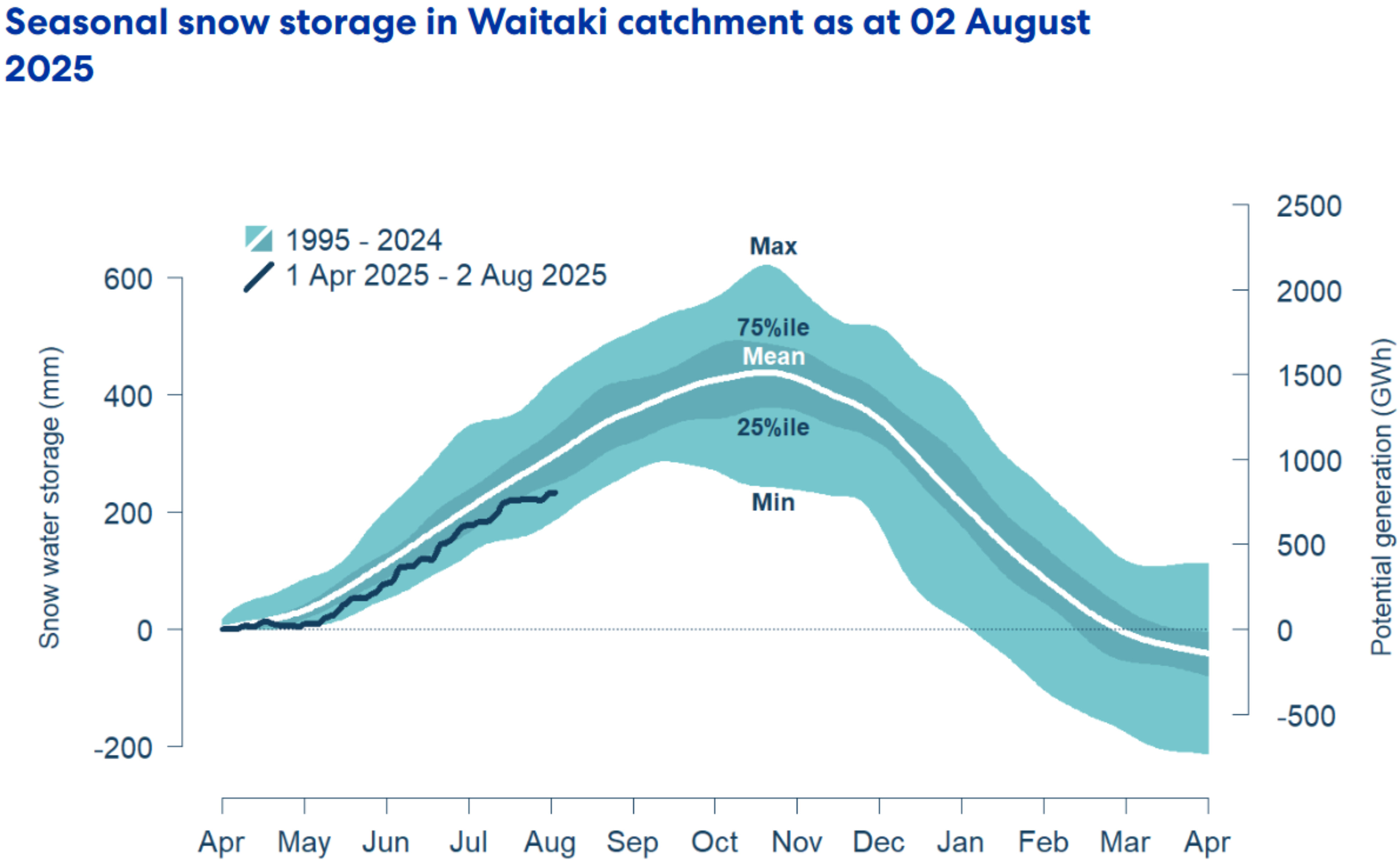
Climate outlook overview July – September 2025 (from NIWA)
- ENSO-neutral (El Niño – Southern Oscillation) conditions remain present in the tropical Pacific but have been trending towards La Niña-like conditions in July 2025.
- This trend was driven in part by shifts in the structure of oceanic heat content and subsurface temperature anomalies in the equatorial Pacific Ocean.
- ENSO-neutral conditions are the most likely outcome (about a 60% chance) over the forecast period (August – October 2025), but compared to ENSO outlooks issued last month, chances for La Niña to emerge by the end of the calendar year have increased.
- Experimental forecasts for the alternative Relative Oceanic Niño Index (RONI), which accounts for the broader warming trend across the tropical Pacific, indicate La Niña conditions are more likely to dominate the forecast period, with a probability close to 60%.
- For New Zealand, atmospheric circulation over the next three-month period is expected to be dominated by northeasterly to easterly air flow anomalies. The likelihood of tropical and subtropical systems influencing New Zealand remains elevated. This continues to be associated with an increased risk of heavy rainfall events, including those linked to atmospheric rivers, and flooding.
- Seasonal air temperatures for the three-month period are expected to be above average for all regions of New Zealand except the east of the South Island, for which above average or near average temperatures are about equally likely. While cold snaps and frost are anticipated, they are expected to be less frequent than usual.
- August – October rainfall totals are expected to be above normal for the north and east of the North Island. Near normal or below normal rainfall is forecast for the west of the South Island. For all remaining regions of New Zealand, near normal or above normal rainfall totals are about equally likely. These anticipated rainfall patterns are driven by circulation anomalies that heighten the risk of heavy rainfall events in the north and east of the North Island. Conversely, a shift toward more persistent easterly flow anomalies is expected as the season progresses, increasing the likelihood of dry conditions in the southwest of the South Island. Sub-seasonal, or monthly, projections of rainfall and dryness are updated daily through the NIWA35 forecast.
- During August – October 2025, soil moisture levels and river flows are expected to be near normal in the north and west of the North Island and near normal or below normal in the east of the North Island. Near normal or above normal soil moisture levels and river flows are forecast for the South Island.
- Sea surface temperatures (SSTs) around New Zealand remain above average, particularly off the west coasts of both the North and South Islands, where Marine Heatwave (MHW) conditions persist. These are defined as periods of five or more consecutive days with SSTs exceeding the 90th percentile for the time of year. Compared to last month, ocean temperatures have warmed east of the North Island, indicating a broadening of unusually warm waters for the time of year. For July 2025 (based on data through 28 July), coastal SST anomalies ranged from +0.8°C off the northern tip of the North Island to +1.5°C off the southwest coast of the North Island. Looking ahead, forecasts for August to October 2025 suggest that above-average SSTs are likely to persist around New Zealand, although the intensity of anomalies may ease slightly. Monitor the SST update for updates.
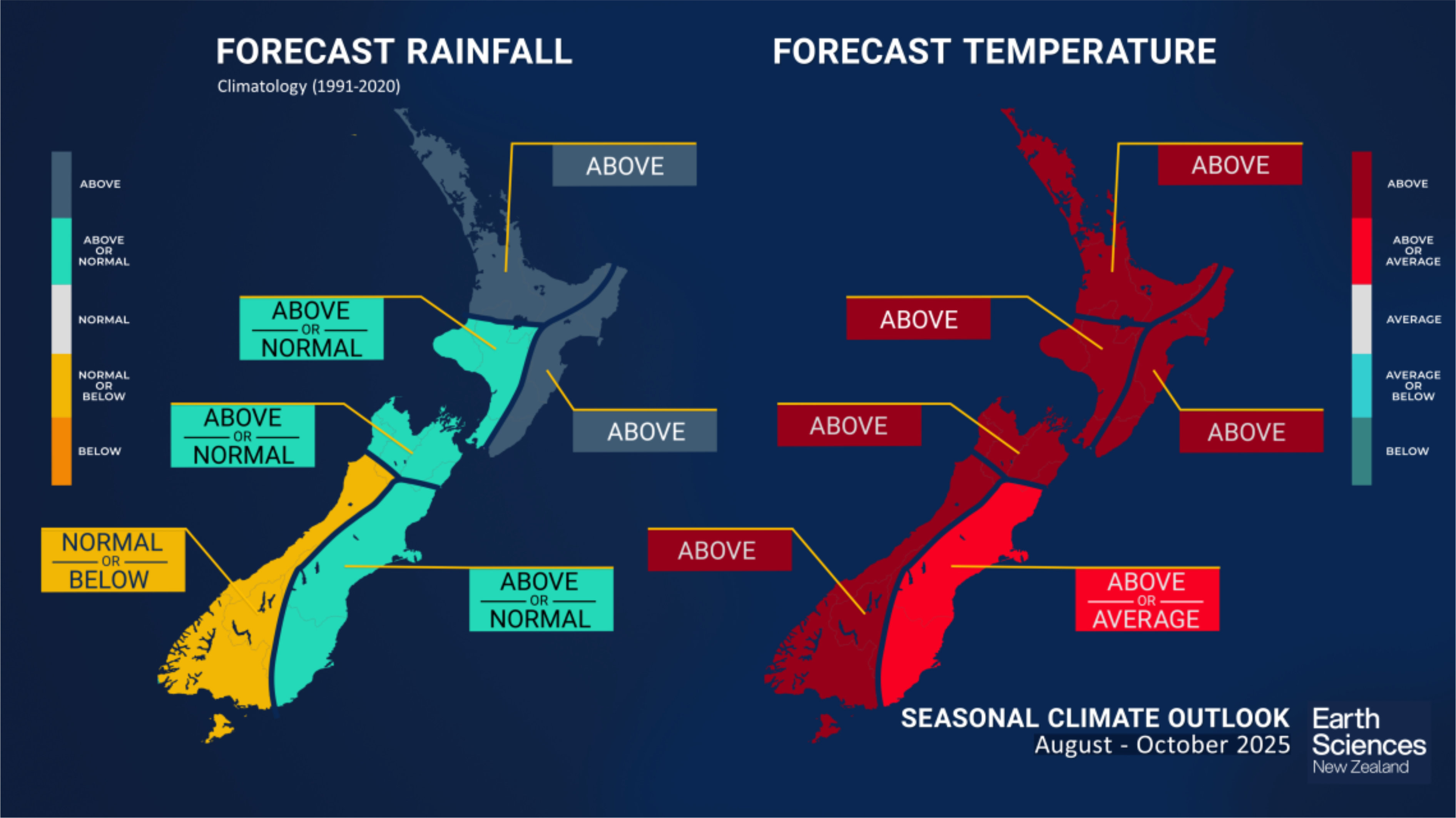
The Wholesale Gas Market
Spot gas prices in July decreased. Prices for the month averaged $14.2/GJ – a 13% decrease compared to June. Average prices were 59% below what they were at the same time last year.
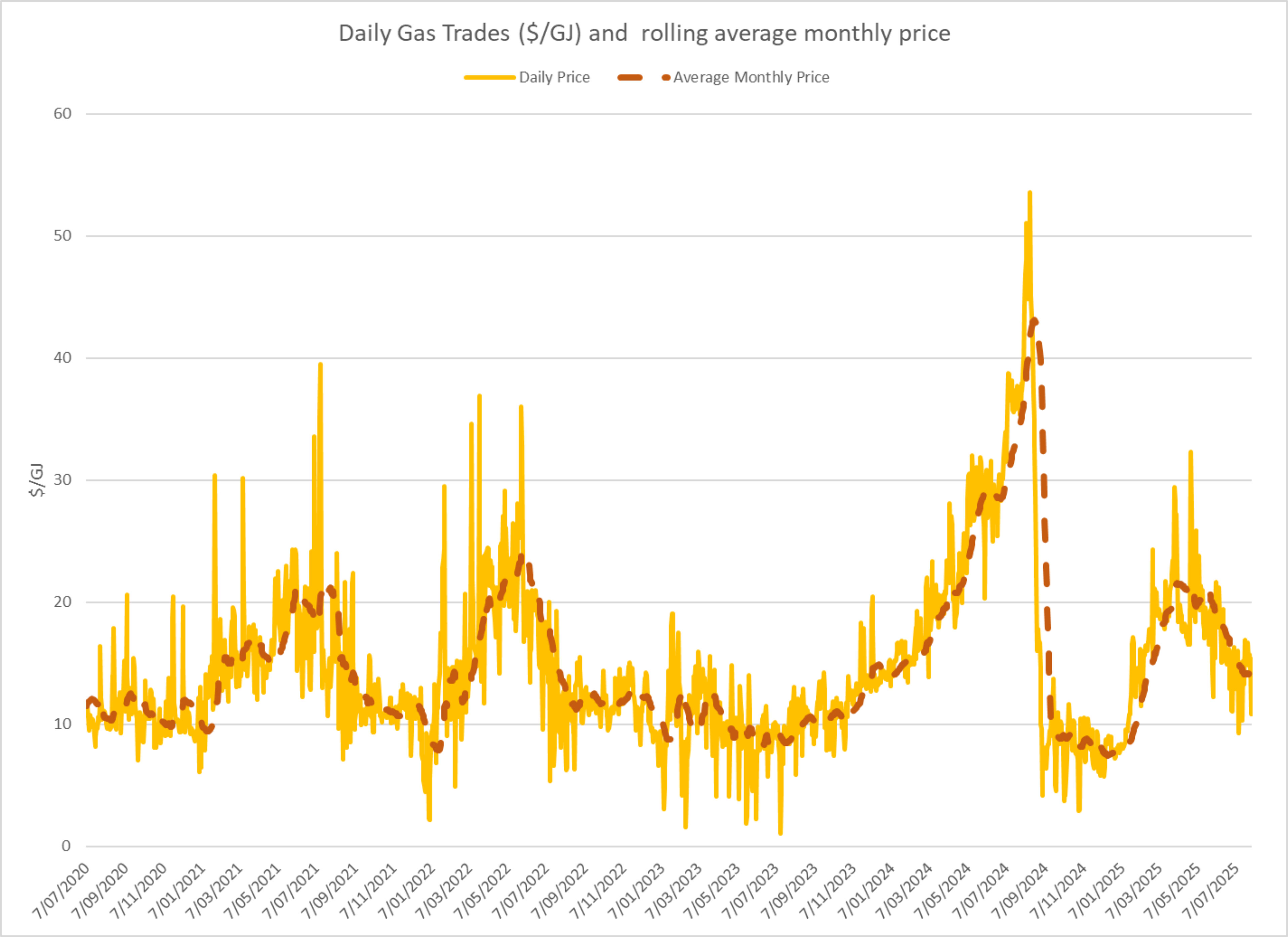
On the supply side most producers maintained output at close to June levels. Maui increased slightly averaging 49TJ/day. Pohokura maintained close to 33TJ/day for most of the month while McKee / Mangahewa was reasonably consistent through the month averaging 55.5TJ/day. Turangi and Kowhai maintained the higher output seen since late January, averaging 62TJ/day.
The following graph shows production levels from major fields over the last 7 years.
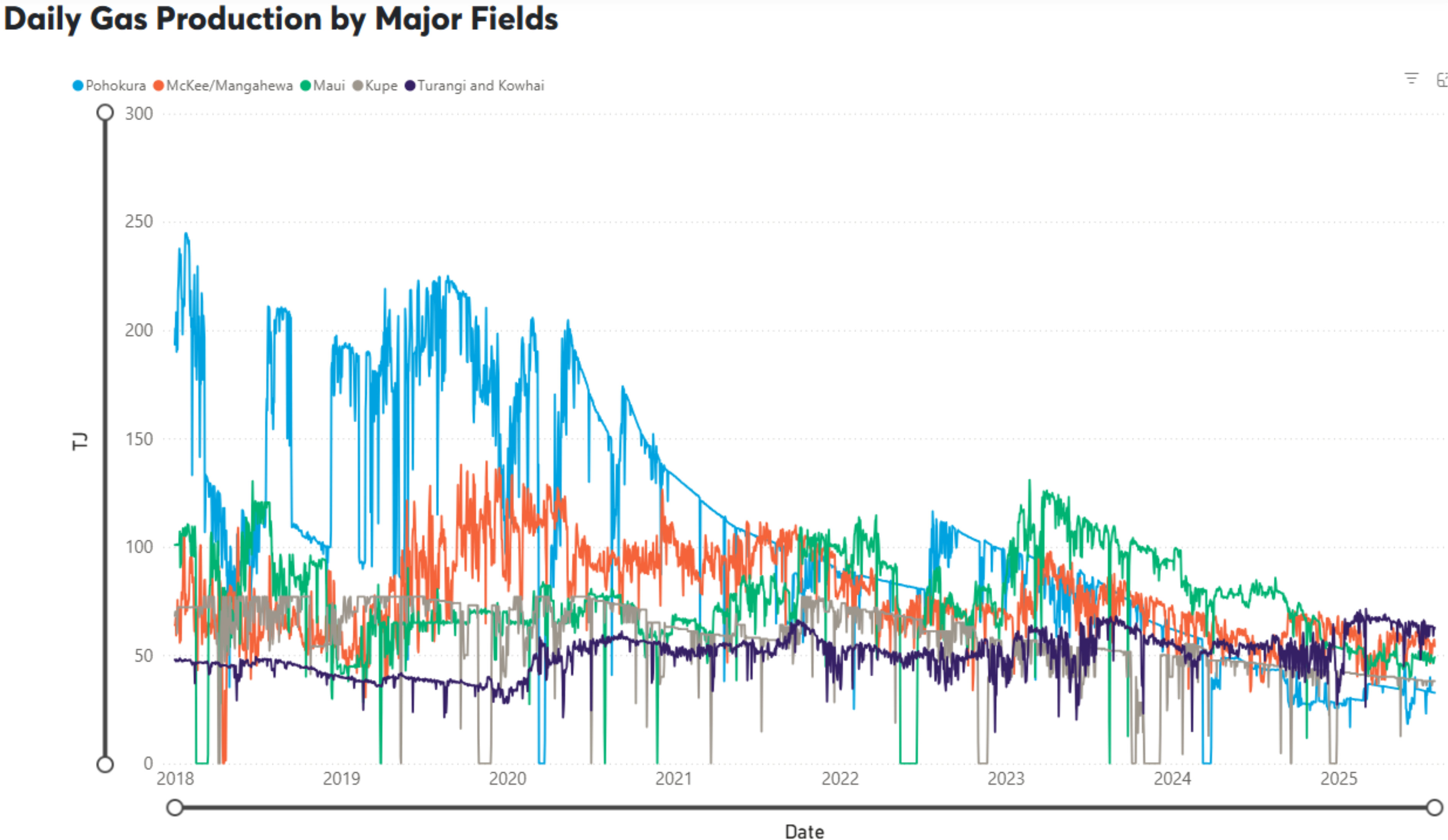
Methanex restarted operations at Motunui on the 1st July, using about 60TJ/day over the month. Huntly maintained usage from last month at 53TJ/day. TCC was off for most of the month.
The following graph shows trends in the major gas users over the last 7 years

Gas storage is becoming increasingly important as falling production coincides with more variable demand particularly from gas fired electricity generation. The following chart shows how storage at Ahuroa decreased slightly through July. It remains well above average levels seen at this time of year over the last few years.
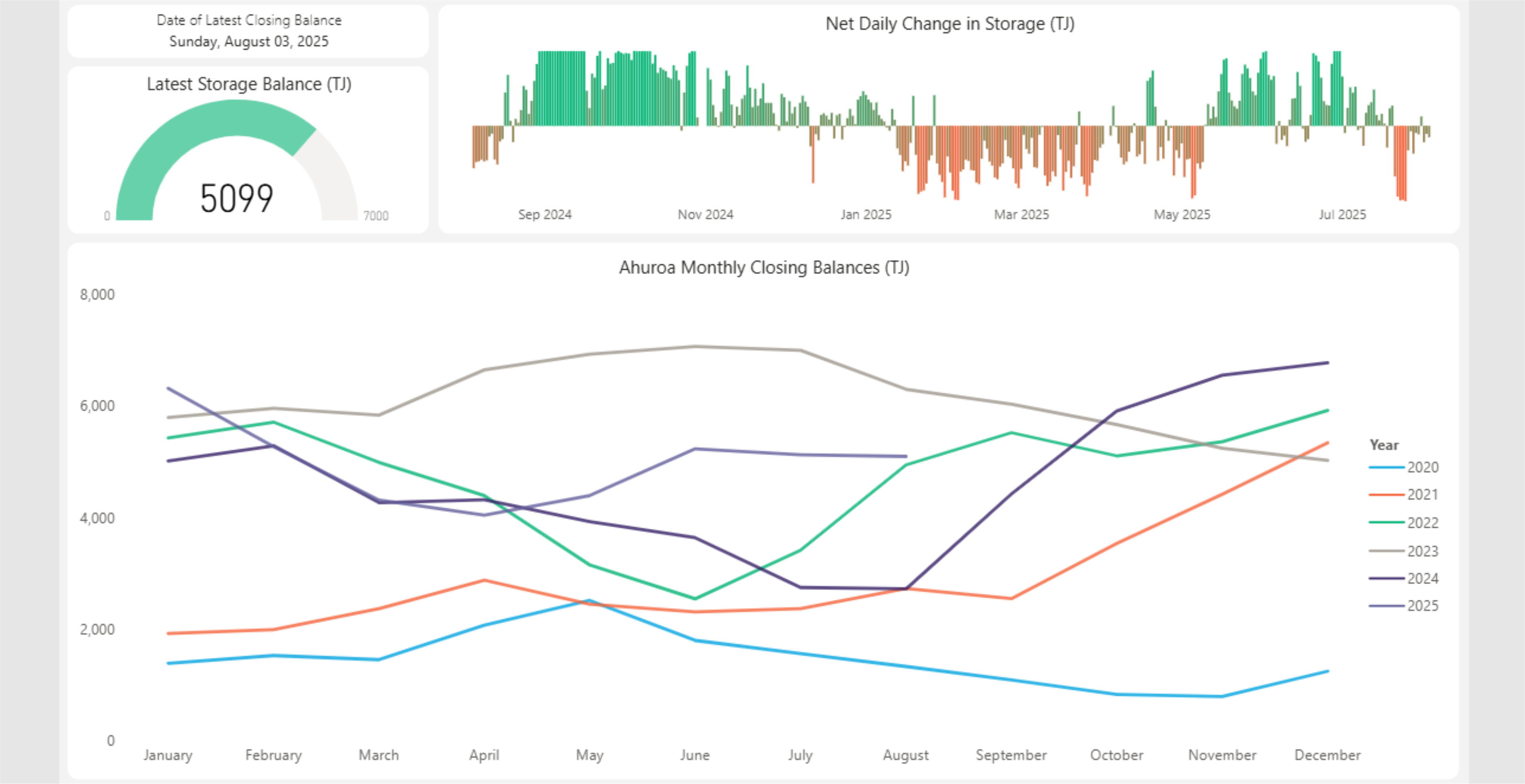
Internationally, LNG netback prices ended the month at $17.23/GJ – up 4% from last month. Forecast prices for 2025 were flat at $17.48/GJ. Forward prices for 2026 were also flat at $16.18/GJ. (Note that netback prices are indicative of international prices – they are produced by the ACCC and quoted in Australian dollars. They are net of the estimated costs to convert from pipeline gas in Australia to LNG, hence the term “netback”)

New Zealand does not (yet) have an LNG export/import market, so our domestic prices are not directly linked to global prices. With recent gas supply issues, the Government is now talking about the possibility of facilitating the building of an LNG import facility.
LPG is an important fuel for many large energy users, particularly in areas where reticulated natural gas is not available. The contract price of LPG is typically set by international benchmarks such as the Saudi Aramco LPG – normally quoted in US$ per metric tonne.
The following graph shows the Saudi Aramco LPG pricing for the last 4.5 years as well as forecast pricing for the year ahead. Futures pricing were down over the last month and remain trending down through 2026.
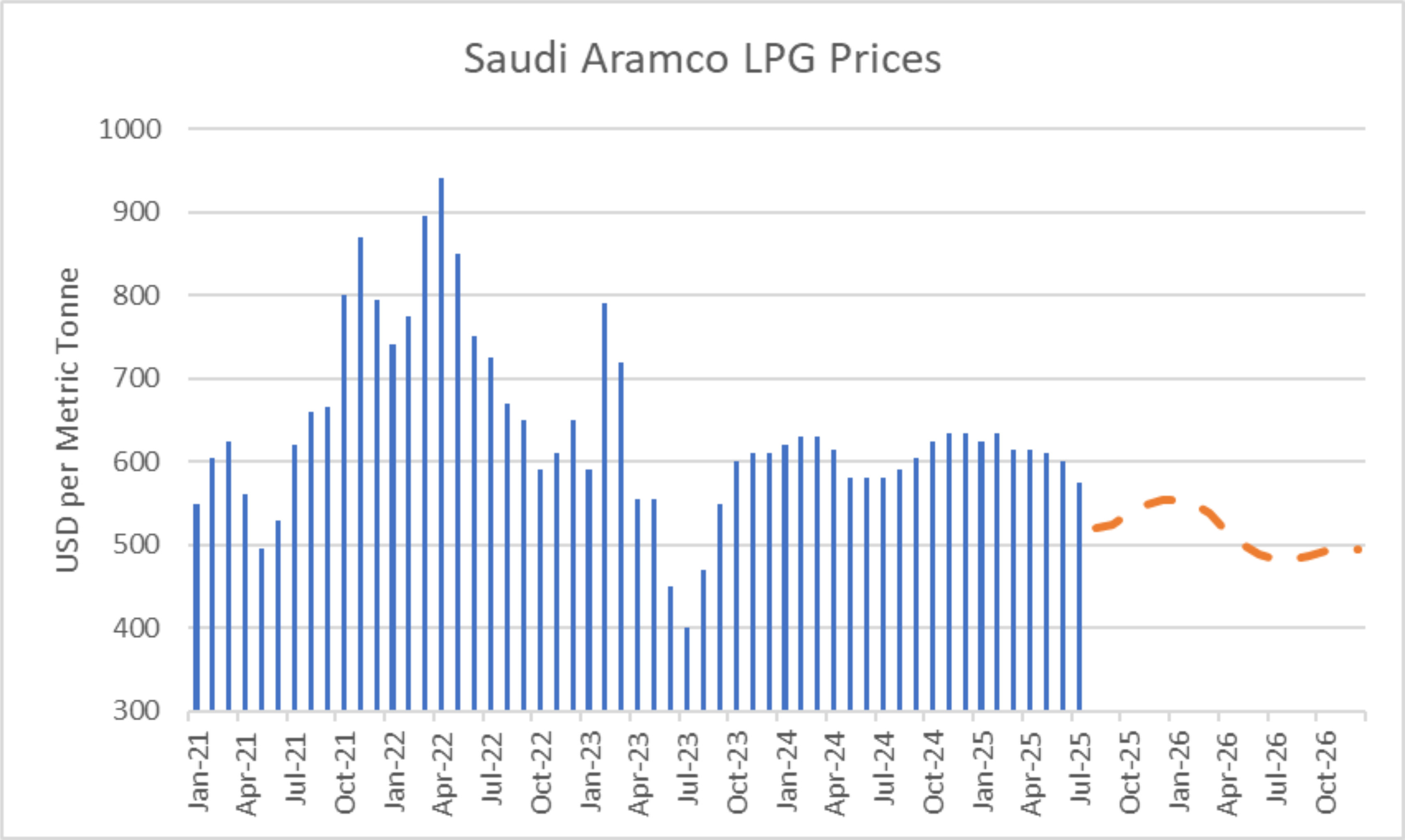
The other main contributing factor to LPG prices in New Zealand is the exchange rate against the USD. The exchange rate hovered around 0.60 for much of July, dropping to 0.59 at the end of the month. This remains near the lowest levels seen in recent years. This remains near the lowest levels seen in recent years. This would tend to push up LPG prices when quoted in NZD.
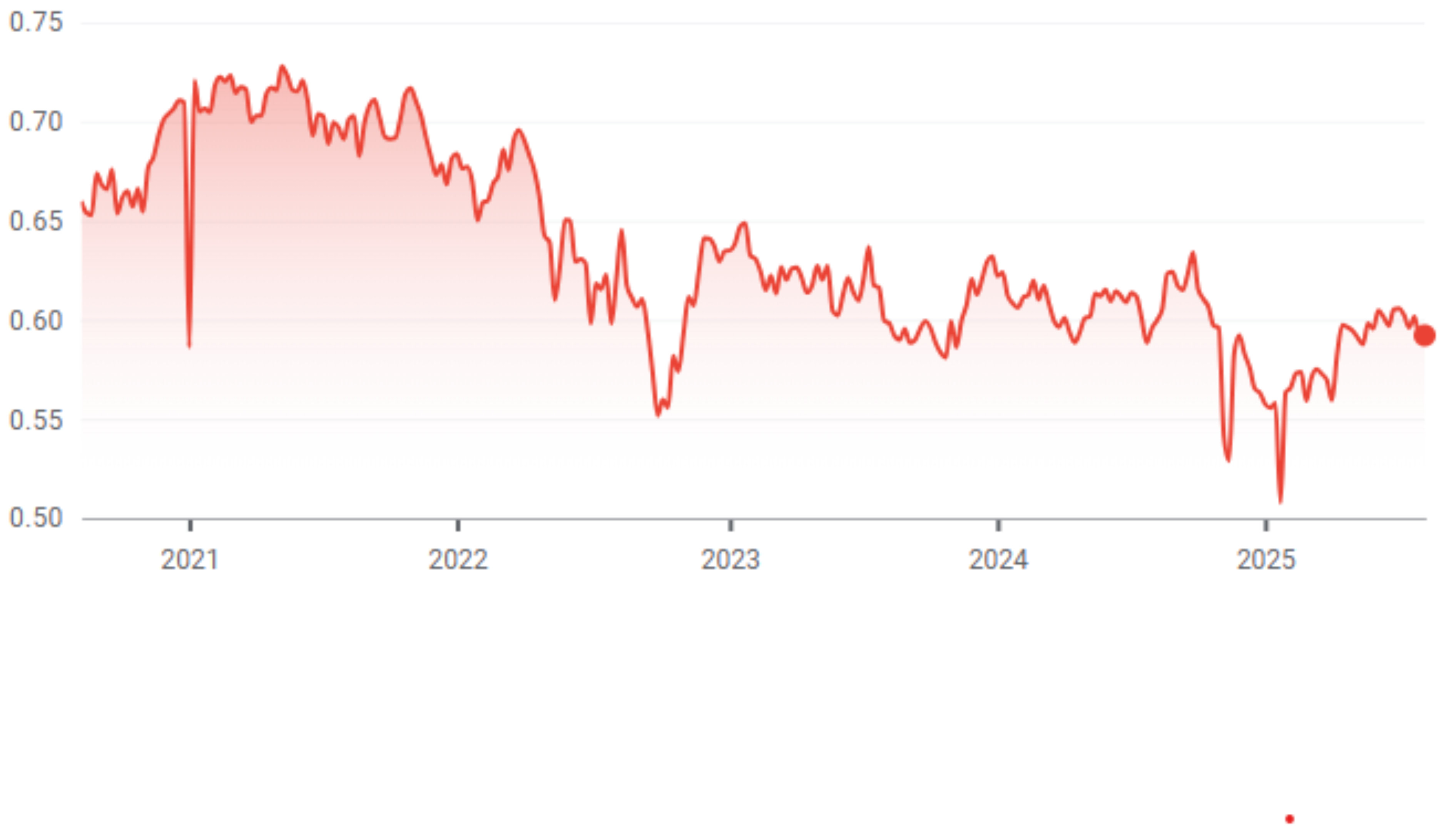
The Coal Market
The global energy crisis has been as much about coal as it has gas. The war in the Ukraine has driven energy prices, including coal, up. Prices in July increased ending the month at US$115/T – a 5.5% rise over the month. These prices are finally returning to levels close to what we expect to see as shown in the following graph of prices over the last 10 years.
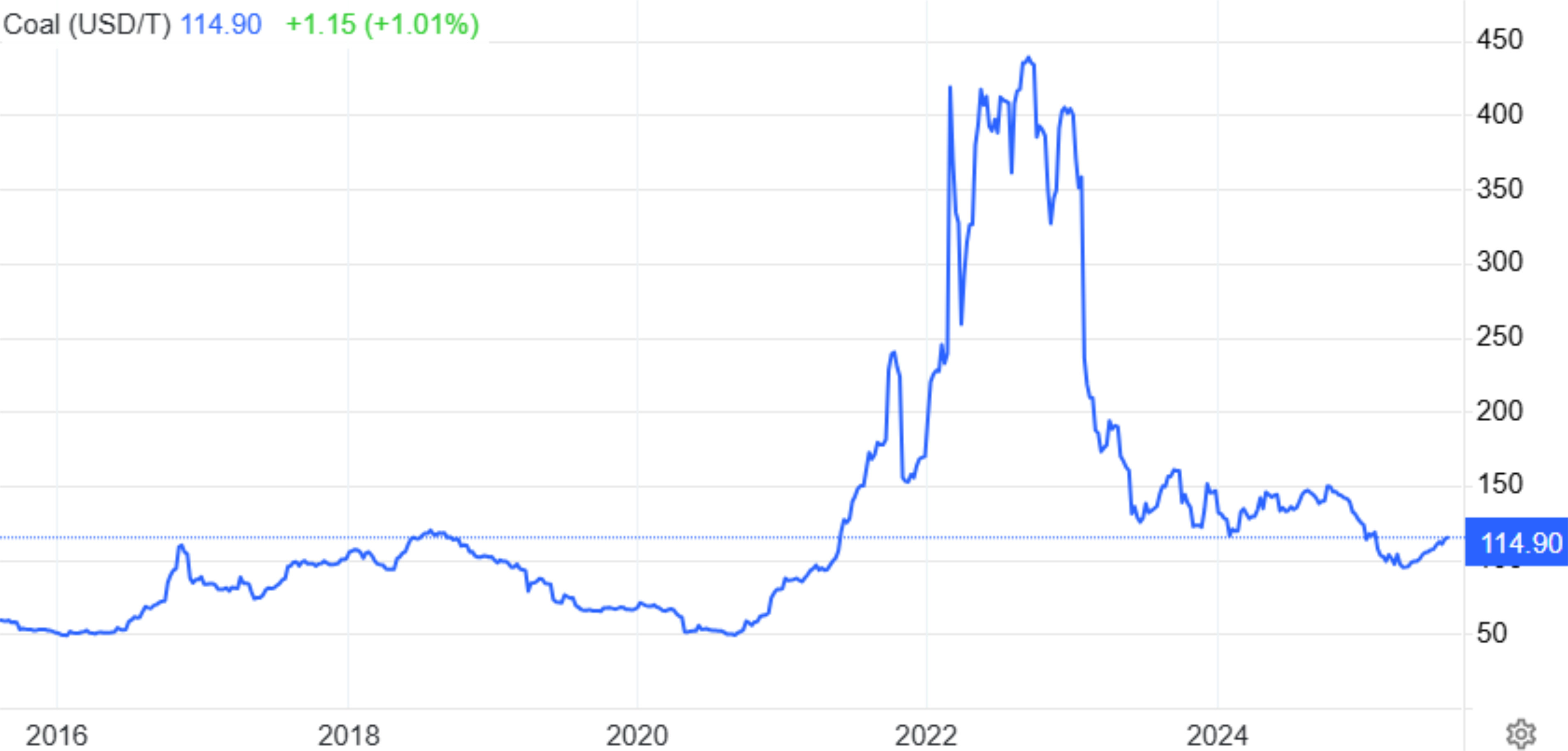
Like gas, the price of coal can flow through and have an impact on the electricity market. In July Genesis reported that it purchased about 186,000 tonnes of coal in the June quarter. The company says it currently holds about 699,000 tonnes at Huntly, up from 474,000 at the end of March and 231,000 a year earlier. Genesis says that 500,000 tonnes is the equivalent of about 1,000GWh of electricity storage or 22% of maximum hydro storage in NZ.
Carbon Pricing
NZ has had an Emissions Trading Scheme (ETS) in place since 2008. It has been subsequently reviewed by several governments and is now an “uncapped” price scheme closely linked to international schemes. However, there are “upper and lower guard-rails” set up to prevent wild swings in carbon price that act as minimum and maximum prices. These increased in December 2023 to $173 and $64 respectively. Carbon prices increased 2% in July to $57.65.
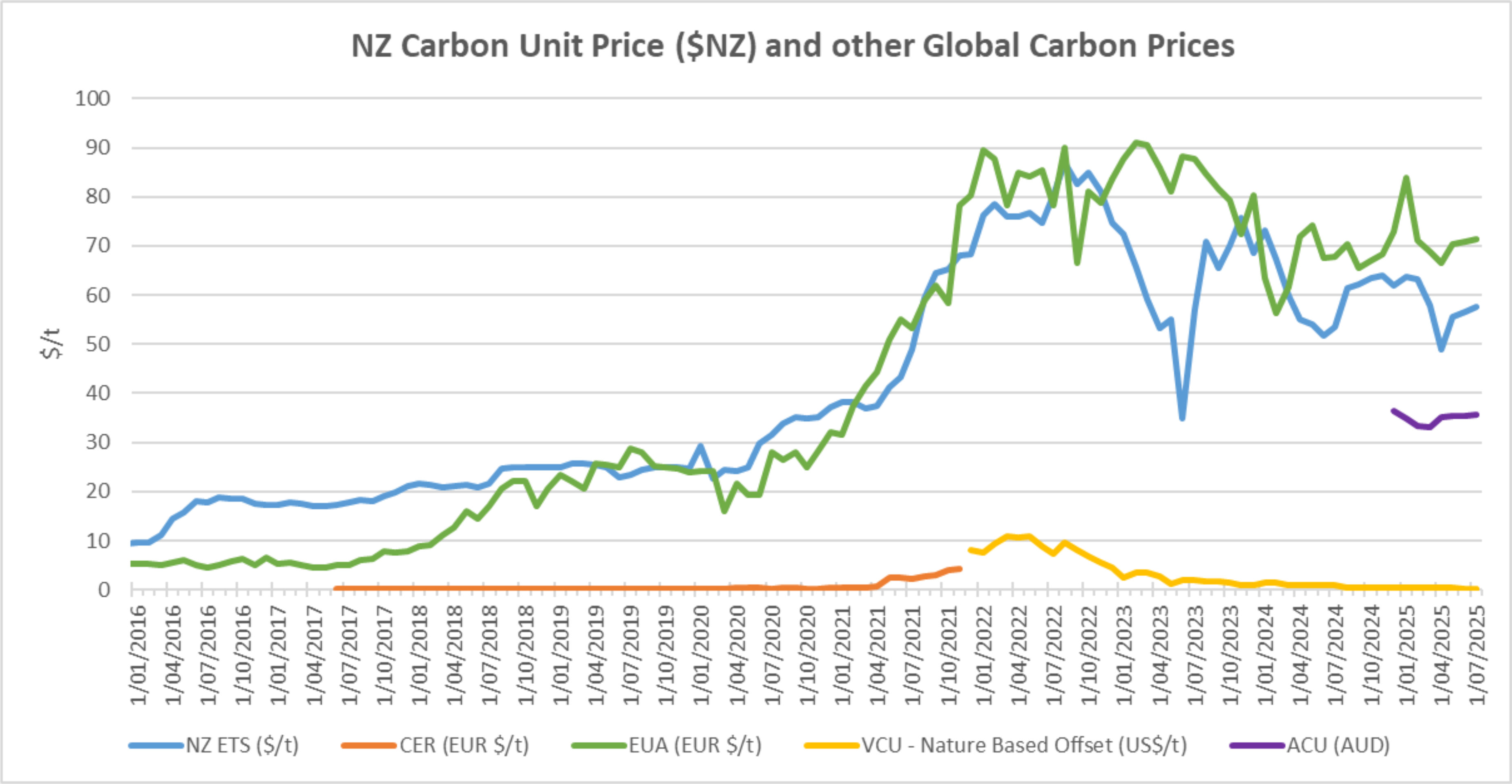
As the carbon price rises, the cost of coal, gas or other fossil fuels used in process heat applications will naturally also rise. Electricity prices are also affected by a rising carbon price. Electricity prices are set by the marginal producing unit – in NZ this is currently typically coal or gas or hydro generators, with the latter valuing the cost of its water against the former. An increase in carbon price can lead to an increase in electricity prices in the short to medium term (as the marginal units set the price). A carbon price of $50/t is estimated to currently add about $25/MWh (or ~2.5c/kWh) to electricity prices. In the long term the impact should reduce as money is invested in more low-cost renewables and there is less reliance on gas and coal fired generation.
EU Carbon units increased in July to 71.3 Euro/tonne – up 1%.
About this Report:
This energy market summary report provides information on wholesale price trends within the NZ Electricity Market. Please note that all electricity prices are presented as a $ per MWh price and all carbon prices as a $ per unit price. All spot prices are published by the Electricity Authority. Futures contract prices are sourced from ASX.
Further information can be found at the locations noted below.
- Transpower publishes a range of detailed information, which can be found here: https://www.transpower.co.nz/power-system-live-data
- The Electricity Authority publishes a range of detailed information, which can be found here: https://www.emi.ea.govt.nz/
- Weather and Climate data – The MetService publishes a range of weather-related information, which can be found here: https://www.metservice.com/
Disclaimer: This document has been prepared for informational and explanatory purposes only and is not intended to be relied upon by any person. This document does not form part of any existing or future contract or agreement between us. We make no representation, assurance, or guarantee as to the accuracy of the information provided. To the maximum extent permitted by law, none of Smart Power Ltd, its related companies, directors, employees or agents accepts any liability for any loss arising from the use of this document or its contents or otherwise arising out of or in connection with it. You must not provide this document or any information contained in it to any third party without our prior consent.
About Smart Power:
Smart Power is a full-service Energy Management consultancy. Apart from Energy Procurement, Smart Power can also provide:
- Technical advice on how to reduce your energy use & emissions
- Sustainability Reporting
- Invoice Management Services
We also offer boutique energy and water billing services for landlords/property developers.
Contact us here or call one of our offices to talk to our experienced staff about how we can assist you with achieving your energy goals.
© Copyright, 2025. Smart Power Ltd




